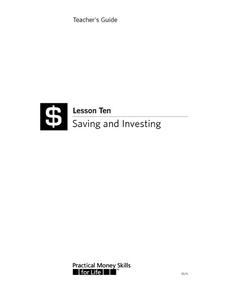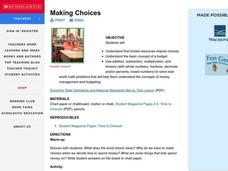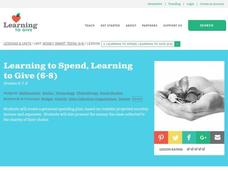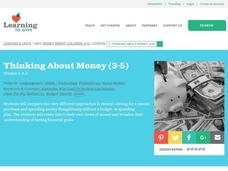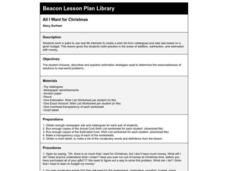Curated OER
Short-Term and Long-Term Savings Goals
Fifth graders discover how saving money can apply to their lives. In this personal finance lesson, 5th graders use the book The Leaves in October, as a conversation starter on income, savings and setting goals. Students explore the...
Curated OER
Uncle Jed's Barbershop
Fourth graders examine productive resources. In this economics lesson, 4th graders read a book about a man who saves money to buy his own barbershop. After reading, students get into groups to play a game to learn about savings.
Curated OER
Budgeting
Students analyze personal budgets. In this budgeting lesson, students examine personal budgeting skills as they listen to a presentation and complete worksheets. Student set up personal budgets.
Curated OER
Where Does All the Money Go?
Students explore the concept of uses for money. For this uses for money lesson, students discuss ways in which money can be utilized such as spending, saving, investing, donating, etc. Students discuss the differences between needs and...
Visa
Allowances and Spending Plans
Help youngsters understand how to manage small amounts of money by discussing an allowance and the difference between spending, saving, and giving.
Visa
Saving and Investing
Impress upon your young adults the importance of saving and investing, and give them a foundational vocabulary from which they can continue to build their financial literacy. This lesson plan covers short- and long-term budget goals,...
Practical Money Skills
Shopping Wisely
Work on making good shopping choices with a fun economics project. Kids analyze the differences between brand names and generic products, bigger and smaller units for purchase, and different places they can shop for different items.
Workforce Solutions
Reality Check
Scholars complete the Reality Chech handout that identifies their potential salary given a specific profession. Pupils examine the lifestyle options and choose what they wish to have; however, each item costs money and, depending on how...
Curated OER
Smart Consumers, Smart Choices
Young scholars see what it means to be a smart consumer by engaging in a level-headed analysis of budget, opportunity costs and self-regulation. They compare prices within a service field, and weigh the choices of spending money on that...
Alabama Learning Exchange
No More Money Trouble
Young consumers explore money identification and counting. In this cross-curricular money instructional activity, they participate in comprehension and writing activities prior to and after reading the book Money Trouble by Bill Cosby....
Curated OER
A Money Plan
Students discuss what a budget is and its purpose. They create a draft of a simple budget that they could possible use. They discuss their trade-offs when they choose to follow a budget.
Curated OER
Making Choices
Students determine that limited resources require choices. They study the basic concept of a budget and use addition, subtraction, multiplication, and division (with whole numbers, fractions, decimals and/or percents, mixed numbers) to...
Curated OER
Budget: Don't Go Broke (NEFE)
Students examine how to plan and maintain a balanced budget. In this financial literacy lesson, teacher students follow the PowerPoint and answer questions based on learned information in order to understand where their money goes and...
Curated OER
Balance the Budget
Young scholars make their own decisions over how central government should spend the money they get from taxing the public. They discuss where they could get more money from and how does spending and taxation outlined in the budget...
Curated OER
Making Choices
Students solve word problems relating to economic choices. In this economic choices lesson, students discuss the importance of budgeting and how to save money. Students complete a economic choices worksheet.
EngageNY
Ratios of Fractions and Their Unit Rates 2
Remodeling projects require more than just a good design — they involve complex fractions, too. To determine whether a tiling project will fit within a given budget pupils calculate the square footage to determine the number of...
Curated OER
Learning to Spend, Learning to Give
Students create a monthly budget. In this finances lesson, students learn the terms budget, income and expenses. Students create a monthly spending plan and keep track of what they make and spend for the next 30 days. When complete,...
Curated OER
The Hundred Penny Box
Students analyze the advantages of regular saving and how savings grow with compounding. After reading the story "The Hundred Penny Box", students define the terms "interest," "interest rate," and "compounding." Through several...
Curated OER
Thinking About Money
Young scholars explore the concept of a personal budget. In this philanthropy lesson, students use a Venn diagram to compare 2 stories in which the main characters spend money in different ways.
Curated OER
Four Dollars and Fifty Cents
Students role play a scenario between a creditor and debtor. In this consumer education lesson, students read the book Four Dollars and Fifty Cents, discuss the vocabulary introduced in the book and role play a situation between a...
California Department of Education
Choosing My Lifestyle
How much does it cost to live the life your dream life? Scholars explore the pitfalls of personal finance through planning, discussion, and research. The first lesson plan in a five-part series tasks individuals with determining an...
Curated OER
All I Want For Christmas
Fourth graders create wish lists from catalogues and sales ads based on a given budget. They add, subtract, estimate, and budget their given amount of money so they don't go over budget.
Curated OER
Eating Away from Home
Young scholars consider the implications of eating out. In this family budgeting lesson, students determine how to make better meal-budgeting choices as they play a game called "Let's Eat Out".
Curated OER
Alexander, Who Used to Be Rich Last Sunday
Fourth graders read the story Alexander, Who Used to Be Rich Last Sunday and discuss money issues. For this money lesson plan, 4th graders create a budget.







